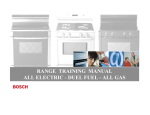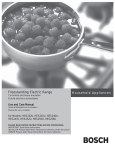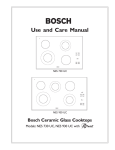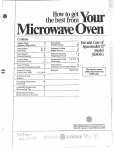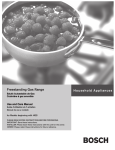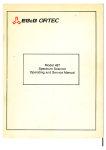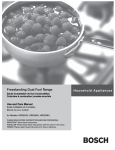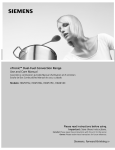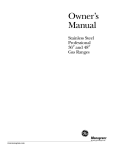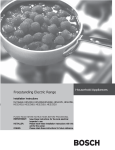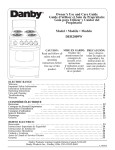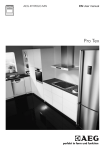Download Bosch Appliances HES232U Range User Manual
Transcript
Household Appliances
Freestanding Electric Range
Use and Care Manual
for Models: HES232U, HES236U
PLEASE READ ENTIRE INSTRUCTIONS BEFORE PROCEEDING.
IMPORTANT: Save these instructions.
INSTALLER: Please leave these instructions with this unit for the owner.
OWNER: Please retain these instructions for future reference.
A Special Message
to Our Customers
Dear Bosch Range Owner:
Thank you and congratulations on the purchase of your Bosch Electric Range. Whether
you are an expert chef or an aspiring cook, we know that your new range will exceed
your expectations. Decades of knowledge and experience are built into this range
making it among the highest quality, most versatile and most efficient available.
We ask that you read this manual thoroughly before using your new range. Please pay
particular attention to the safety precautions printed at the front of this book and the
numerous safety hints and cautions placed throughout. Also, be sure to familiarize
yourself with the proper operation of the range and its cleaning and maintenance
procedures. Adherence to these instructions and procedures will assure that you realize
the full potential of your new Bosch range as well as maintain it for years of dependable
use.
Thank you and good cooking,
BSH Home Appliances Corporation
IMPORTANT SAFETY NOTICE
The California Safe Drinking and Toxic
Enforcement Act requires the Governor of
California to publish a list of substances known
to the state to cause cancer, birth defects or
other reproductive harm, and requires
businesses to warn customers of potential
exposure to such substances.
WARNING
When properly cared for, your new Bosch range has
been designed to be a safe, reliable appliance. Read all
instructions carefully before using this range. These
precautions will reduce the risk of burns, electric shock,
fire, and injury to persons. Do not operate the oven or
cooktop controls if the glass is broken. Food splatter or
cleaning solution may penetrate a broken control panel
and create a risk of electric shock. Contact a qualified
technician immediately should your glass control panel
become broken. When using kitchen appliances, basic
safety precautions must be followed, including those in
the following pages.
The elimination of soil during self-cleaning
generates some by-products which are on the
list.
The fiberglass insulation in self-clean ovens
gives off very small amounts of formaldehyde
during the first several cleaning cycles.
Exposure to these substances can be
minimized by:
1. Providing good ventilation when cooking
with gas
2. Providing good ventilation during and
immediately after self cleaning the oven.
3. Operating the unit according to the
instructions in this manual.
The Bosch range referred to thoughout this manual is manufactured by BSH Home Appliance Corp.
Table of Contents
Important Safety Instructions .............................................................................. 1
Getting Familiar with Your Range .......................................................................... 3
Setting Up Your Range
Setting and Changing the Clock ..............................................................................
Setting the Functions ............................................................................................
Accessing and Using the Select Functions Menu ................................................
Volume .........................................................................................................
Change Temperature Scale .............................................................................
Lock Keys .....................................................................................................
Time Format .................................................................................................
Language Option ...........................................................................................
Clock Display .................................................................................................
Oven Temperature Offset ...............................................................................
Demo Mode ..................................................................................................
Reset Defaults ...............................................................................................
Sabbath Feature ............................................................................................
5
6
6
7
7
7
7
7
8
8
8
8
8
The Cooktop
Cooktop Features ................................................................................................. 9
Operating the Mechanical Cooktop ......................................................................... 10
The Oven
Oven Features ....................................................................................................
Oven Modes - Bake and Convection Bake ................................................................
Oven Modes - Broil ...............................................................................................
Oven Modes - Convection Roast .............................................................................
Selecting the Mode ...............................................................................................
Using the Timer (s) ..............................................................................................
Using Timed Cook ................................................................................................
11
12
13
14
15
16
17
Care and Cleaning
Cooktop .............................................................................................................. 18
Oven ................................................................................................................... 20
Guides, Self Help and Maintenance
Cookware Selection Guide .....................................................................................
Maintenance
Removing the Oven Door ................................................................................
Replacing the Oven Light ................................................................................
Self Help
Cooktop ........................................................................................................
Oven ............................................................................................................
Customer Service and Warranty ............................................................................
23
24
24
25
26
27
A Special Message
to Our Customers
Dear Bosch Range Owner:
Thank you and congratulations on the purchase of your Bosch Electric Range. Whether
you are an expert chef or an aspiring cook, we know that your new range will exceed
your expectations. Decades of knowledge and experience are built into this range
making it among the highest quality, most versatile and most efficient available.
We ask that you read this manual thoroughly before using your new range. Please pay
particular attention to the safety precautions printed at the front of this book and the
numerous safety hints and cautions placed throughout. Also, be sure to familiarize
yourself with the proper operation of the range and its cleaning and maintenance
procedures. Adherence to these instructions and procedures will assure that you realize
the full potential of your new Bosch range as well as maintain it for years of dependable
use.
Thank you and good cooking,
BSH Home Appliances Corporation
IMPORTANT SAFETY NOTICE
The California Safe Drinking and Toxic
Enforcement Act requires the Governor of
California to publish a list of substances known
to the state to cause cancer, birth defects or
other reproductive harm, and requires
businesses to warn customers of potential
exposure to such substances.
WARNING
When properly cared for, your new Bosch range has
been designed to be a safe, reliable appliance. Read all
instructions carefully before using this range. These
precautions will reduce the risk of burns, electric shock,
fire, and injury to persons. Do not operate the oven or
cooktop controls if the glass is broken. Food splatter or
cleaning solution may penetrate a broken control panel
and create a risk of electric shock. Contact a qualified
technician immediately should your glass control panel
become broken. When using kitchen appliances, basic
safety precautions must be followed, including those in
the following pages.
The elimination of soil during self-cleaning
generates some by-products which are on the
list.
The fiberglass insulation in self-clean ovens
gives off very small amounts of formaldehyde
during the first several cleaning cycles.
Exposure to these substances can be
minimized by:
1. Providing good ventilation when cooking
with gas
2. Providing good ventilation during and
immediately after self cleaning the oven.
3. Operating the unit according to the
instructions in this manual.
The Bosch range referred to thoughout this manual is manufactured by BSH Home Appliance Corp.
Table of Contents
Important Safety Instructions .............................................................................. 1
Getting Familiar with Your Range .......................................................................... 3
Setting Up Your Range
Setting and Changing the Clock ..............................................................................
Setting the Functions ............................................................................................
Accessing and Using the Select Functions Menu ................................................
Volume .........................................................................................................
Change Temperature Scale .............................................................................
Lock Keys .....................................................................................................
(cut here)
Time Format .................................................................................................
Language Option ...........................................................................................
Clock Display .................................................................................................
Oven Temperature Offset ...............................................................................
Demo Mode ..................................................................................................
Reset Defaults ...............................................................................................
Sabbath Feature ............................................................................................
5
6
6
7
7
7
7
7
8
8
8
8
8
The Cooktop
Cooktop Features ................................................................................................. 9
Operating the Mechanical Cooktop ......................................................................... 10
The Oven
Oven Features ....................................................................................................
Oven Modes - Bake and Convection Bake ................................................................
Oven Modes - Broil ...............................................................................................
Oven Modes - Convection Roast .............................................................................
Selecting the Mode ...............................................................................................
Using the Timer (s) ..............................................................................................
Using Timed Cook ................................................................................................
11
12
13
14
15
16
17
Care and Cleaning
Cooktop .............................................................................................................. 18
Oven ................................................................................................................... 20
Guides, Self Help and Maintenance
Cookware Selection Guide .....................................................................................
(cut here)
Maintenance
Removing the Oven Door ................................................................................
Replacing the Oven Light ................................................................................
Self Help
Cooktop (cut here) .........................................................................................
Oven (cut here) .............................................................................................
Customer Service and Warranty ............................................................................
23
24
24
25
26
27
Important Safety Instructions
Please read all instructions before using this appliance.
RANGE SAFETY
APPLIANCE SAFETY
• This appliance must be properly installed and grounded by
a qualified technician. Connect only to properly grounded
outlet. Refer to Installation Instructions for details.
• This appliance should be serviced only by a qualified service
technician. Contact the nearest authorized service center
for examination, repair or adjustment.
• Do not repair or replace any part of the range unless
specifically recommended. Refer service to an authorized
servicer.
• Do not operate this appliance if it is not working properly
or if it has been damaged, until an authorized servicer has
examined it.
• Use this appliance only for its intended use as described in
this manual. If you have any questions, contact the
manufacturer.
• Do not cover or block any openings on this appliance.
• Do not use corrosive chemicals, vapors, or nonfood products
in this appliance. This type of range is specifically designed
to heat or cook. It is not designed for industrial or laboratory
use. The use of corrosive chemicals in heating or cleaning
will damage the appliance.
• In the event that personal clothing or hair catches fire,
DROP AND ROLL IMMEDIATELY to extinguish flames.
• Do not allow children to use this appliance unless closely
supervised by an adult. Children and pets should not be left
alone or unattended in the area where the appliance is in
use. They should never be allowed to sit or stand on any
part of the appliance.
PERSONAL SAFETY
WARNING
To reduce the risk of injury to persons, in the event of a
grease fire, observe the following:
• In the event of a grease fire SMOTHER FLAMES with a closefitting lid, cookie sheet, or other metal tray, then turn off the
elements. BE CAREFUL TO PREVENT BURNS. If the flames do
not go out immediately, EVACUATE AND CALL THE FIRE
DEPARTMENT.
• Do not use water, including wet dishcloths or towels on grease
fires. A violent steam explosion may result.
• SMOTHER FLAMES from other types of food fires with baking
soda. NEVER use water on cooking fires.
• NEVER PICK UP A FLAMING PAN. You may be burned.
• ALWAYS have a working SMOKE DETECTOR near the kitchen.
• LEAVE THE HOOD VENTILATOR ON when flambéing food.
• Use an extinguisher ONLY IF:
• You know you have a Class ABC extinguisher, and you already
know how to operate it.
• The fire is small and contained in the area where it started.
• The fire department is being called.
• You can fight the fire with your back to an exit.
• Tie long hair so that it does not hang loose.
• The heating elements may be hot even though they are not
red in color. Interior surfaces of an oven become hot enough
to cause burns.
• Do not touch heating elements or interior surfaces of oven
during operation.
• During and after use, do not touch or let clothing or other
flammable materials contact the heating elements or the
interior surfaces of the oven until they have had sufficient
time to cool.
• The trim on the sides of the oven door may become hot
enough to cause burns.
• Use care when opening the door. Open the door slightly to
let hot air or steam escape before removing or replacing
food.
• Do not heat unopened food containers. Build-up of pressure
may cause the container to burst and cause injury.
• Always place oven racks in desired location while oven is
cool. If a rack must be moved while oven is hot, do not let
potholder contact the hot heating elements.
• Use only dry potholders. Moist or damp potholders on hot
surfaces may result in burns from steam. Do not let potholder
touch hot heating elements. Do not use a towel or other
bulky cloth.
• Keep the oven free from grease build up.
• Do not place food directly on oven bottom.
• When using cooking or roasting bags in the oven, follow the
manufacturer’s directions.
• Do not use aluminum foil to line oven bottoms, except as
suggested in this manual. Improper installation of aluminum
foil many result in a risk of electric shock or fire.
• To avoid electric shock, do not operate the oven without the
light bulb cover in place.
COOKTOP SAFETY
• Do not cook on a cooktop in which the glass top has broken.
If the cooktop glass should break, do not use it or attempt
to clean or fix it. Cleaning solutions and spillovers may
penetrate the broken cooktop and create a risk of electric
shock. Turn off electric circuit to the cooktop and call an
authorized service agency immediately.
• When using the cooktop, DO NOT TOUCH THE HOT
COOKING AREA OR THE IMMEDIATE SURROUNDING
AREA. Even though dark in color, these areas may be hot.
Areas adjacent to the elements may become hot enough to
cause burns. Never let clothing, potholders, or other
flammable materials come in contact with a cooking area
until it has cooled.
• Use high heat settings on the cooktop only when necessary. Use
low to medium settings to heat oil slowly.
• Never move a pan of hot oil, especially a deep fat fryer. Wait until
it is cool.
Page 1
Important Safety Instructions
Please read all instructions before using this appliance.
COOKTOP SAFETY (cont’d)
SELF-CLEANING SAFETY
• Never leave the cooktop unattended. Boilovers can cause smoke
and possibly damage the cooktop.
• Hold the handle of the pan to prevent movement of the utensil
when stirring or turning food.
• Other than the use of metal pans, only certain types of glass,
heatproof glass ceramic, ceramic, earthenware, or other glazed
utensils are suitable for cooktop use. Other types of utensils may
break with sudden temperature changes. Use only on low or
medium heat settings according to the utensil manufacturer’s
directions.
• Confirm that the door locks and will not open once the
door lock indicator icon appears. If the door does not lock,
touch OFF and do not run Self-Clean. Phone
800/944-2904 for service.
• Note: During a normal Self-Clean cycle, the door will not
lock until the oven reaches 450º F. In a Delayed Self-Clean
cycle, the door locks immediately.
• Do not clean the oven gasket. It is essential for a good seal.
Care should be taken not to rub, damage, move or remove
the oven gasket.
• Do not use commercial oven cleaners or oven liner protective
coatings of any kind in or around any part of the oven.
• Clean only oven parts listed in this manual.
• Before self-cleaning the oven, remove the broiler pan,
oven racks, oven probe, other utensils and wipe out
excess soft spillage.
OVEN SAFETY
To reduce the risk of fire:
• Do not store flammable materials in or near the oven.
• Do not use water on a grease fire. Smother fire or use a
dry chemical or foam-type extinguisher.
• Have an appropriate fire extinguisher available and highly
visible near any cooking appliance.
• Do not use the cavity for storage purposes. Do not leave
paper products, cooking utensils or food in the cavity when
not being used.
• If materials inside the oven should ignite, keep oven door
closed. Turn off oven and disconnect the circuit at the
circuit breaker box.
• Do not block any vent openings.
• Never use the oven to warm or heat a room. This can
damage the oven parts.
• Never wear loose-fitting or hanging garments while using
the appliance. Be careful when reaching for items stored
over the range. Flammable material could be ignited if
brought in contact with hot surface units or heating elements
and may cause severe burns.
• Do not allow anyone to climb, stand or hang on the oven
door, warming drawer door, storage drawer or cooktop.
This can damage the range and even tip it over, causing
severe personal injury.
• Have the installer show the location of the circuit breaker
or fuse. Mark it for easy reference.
REGARDING PET BIRDS:
Birds have very sensitive respiratory systems. Keep pet birds
out of the kitchen or other rooms where kitchen fumes could
reach them. During self clean, fumes are released that may
be harmful to birds. Other kitchen fumes such as overheating
margarines and cooking oils may also be harmful.
Page 2
CAUTION
Items of interest to children should
not be stored in cabinets above a
range or on the backsplash of a range.
Children climbing on the range to
reach items could be seriously injured.
Getting Familiar with Your Range
Parts Included with Your
Electric Range:
1.
2.
3.
4.
5.
6.
7.
8.
9.
10.
11.
12.
13.
14.
15.
16.
17.
18.
19.
20.
21.
22.
23.
24.
Use & Care Manual
Installation Instructions
AHAM Anti-Tip Brochure
Oven Vent
Anti-Tip Bracket
Screws for Anti-Tip Bracket
Ceran Cooktop Scraper
Cooktop Cleaning Solution (not visible)
Registration Card
Incandescent Light (not visible)
Oven Control
Panel and Knob
Broil Element (not visible)
Convection Fan and Element (not visible)
Rack Positions
Door Gasket
Model & Serial # Plate
Bake Element (not visible)
Door Lock (not visible)
Oven Rack Back
Oven Rack Front
Broiler Pan
Broiler Pan Racks (not shown)
Storage Drawer
12
11
19
16
4
15
17
24
20
7
COOKTOP
SCRAPER
OVEN RACK
21
BROIL PAN
22
ANTI-TIP
BRACKETS
AND SCREWS
Actual parts are larger than depicted in above graphics.
Page 3
5&6
Getting Familiar with Your Range
The Oven Control Panel
Light
Time
Cooking Mode
Clock
Light
AM
PM
Cooking Mode
C
F
Time
Temperature
Temperature
BAKE
Start
Off
Off
Oven
Temperature
Lock
Indicator
Preheat
Temperature
Start
Display Window Features
CLOCK– Shows the time of day with a 12-hour or 24-hour
clock option.
Control Knob
Other Indicators and Features
COOKING MODE - Touch pad to display cooking mode.
BEEP - Signals that more information must be entered or
confirms the receipt of an entry. A Beep also signals the
end of a program or an oven error.
COOKING OR TIMED MODE – Shows the number of hours
and minutes the oven will be “on.” Cooking Mode Icon is also
displayed when cooking mode is seleceted.
DEFAULT SETTINGS - The cooking modes automatically
select the default temperature. These can be changed
when a different one is needed.
CONTROL KNOB - Used to set the clock, timers, select
cooking mode and temperature. Turn clockwise to increase
and turn counterclockwise to decrease.
ELEMENTS – Displays which element(s) are active during a
cooking mode.
LIGHT - Touch pad to turn oven light on or off.
DOOR LOCK INDICATOR - Icon is displayed during the
self- clean mode when the door is locked. DO NOT attempt
to open the door until the lock symbol is no longer present.
OFF - Touch pad to turn off oven and/or warming drawer.
OVEN TEMPERATURE - Shows the oven temperature
selected.
FLASHING SYMBOL OR NUMBER - Signals an
incomplete setting and calls for another step or START to
be touched.
F NUMBER CODES - These codes are displayed when
there is a problem with the signal sent to the electronic
control board.
CONVECTION FAN - The convection fan operates during
any convection mode. When the oven is operating in the
convection mode, the fan will turn off automatically when
the door is opened except when in the dehydrate mode.
The convection fan will also run during the preheat time
for specific modes.
PREHEAT - Displays temperature of oven during preheat
mode. Also displays internal temperature of meat when probe
is in use.
START - Touch pad to complete an entry.
TEMPERATURE - Touch pad to select cooking temperature.
TIMER – There are two timers- TIMER 1 AND TIMER 2; Each
counts down the time in hours and minutes. With less than
60 minutes remaining, the timer also displays seconds.
Page 4
Setting Up Your Range
Setting the Clock (after power to the range has been off)
•
•
•
•
Always set the clock after installation or after a power failure. Once power returns to the oven, the clock defaults to 12:00 am.
The time of day is displayed in hours and minutes.
The clock time will appear during all oven operations except when the timer or a timed cooking operation is running.
The oven is preset to a 12-hour clock and indicates AM and PM.
Note: To switch to a 24 hr. clock, see "Select Function” section.
1. CLOCK will be displayed and the hour digits will flash.
Turn knob to select hour and AM or PM. Turning to the right
increases by 1 hour increments; turning to the left decreases
by 1 hour increments.
2.
Touch TIME. CLOCK will still be displayed and the
minute digits will flash.
3.
Turn knob. Set minutes.
4.
Touch TIME and the clock is now set.
12 : 00
AM
CLOC
K
CLOCK
BEEP REMINDER
If operation is not completed,the
oven will beep periodically as a
reminder to set clock time. Push
Off.
Changing the Clock Time
1.
Touch TIME. TIMER 1 will flash in display.
2.
Turn knob to select CLOCK .
3.
Touch TIME again and hour digits will flash.
4.
Turn knob to change hours.
5.
Touch TIME again and minute digits will flash.
6.
Turn knob clockwise or counter-clockwise to change minutes.
7.
Touch TIME again and the clock is set.
0: 00
HR:MIN
TIMER
AM
TIMER 1
Helpful Hint
To cancel the Time selection
when setting the clock, touch
Off at any time while in the
clock mode.
Page 5
Setting Up Your Range
SELECT FUNCTIONS is the section of the menu where you can set or change the following features on your range:
VOLUME (decrease or increase loudness
of control beeps)
TEMPERATURE FORMAT (switch temperature
scale to Fahrenheit or Celsius)
TIME FORMAT (12 hr or 24 hr)
LOCK KEYS (oven control pad lockout )
LANGUAGE OPTION (for display; select English,
Spanish, or French)
CLOCK DISPLAY (yes or no)
OVEN TEMPERATURE OFFSET (used to
calibrate the oven temperature)
DEMO
DEMO MODE (used by appliance stores)
RESET DEFAULTS (change all function settings
back to original factory settings)
SABBATH FEATURE (for religious faiths with “no
work” requirements on the Sabbath)
NOTE: In the event of a power failure, the functions return
to the factory settings and will need to be reset.
TIPS on Using Functions
Accessing and Using the Select Functions
Menu
To access the SELECT FUNCTIONS menu, touch and hold
COOKING MODE touch pad for five (5) seconds.
SELECT FUNCTION is displayed.
1.
2.
3.
4.
Turn knob to desired feature.
Press START to choose any function, and turn knob
to choose any sub-functions.
After selecting feature, touch OFF.
Touch OFF again to exit the select functions menu.
• There will be a slight delay before
each message (or feature) can be
seen in the display.
• Turn knob slowly, and wait
approximately one second for display
to show next feature.
• To move through the feature
menu, slowly turn the knob clockwise
one click after each feature appears.
BEEPS
To indicate when a mode is done,
3 consecutive beeps will sound.
Page 6
Setting Up Your Range
BEEP VOLUME
•
•
The volume of the control beep can be changed from LOW
(softest) to HIGH (loudest).
The control default for beep volume is Medium.
Changing the beep volume
1.
2.
3.
4.
5.
Access SELECT FUNCTION Menu.
Turn knob clockwise slowly until VOLUME is displayed.
Touch START.
Turn knob to select volume level Low, Medium or High.
Touch START.
CHANGE TEMPERATURE
•
•
The oven has been preset to the Fahrenheit temperature
scale.
The feature allows you to switch between Fahrenheit and
Celsius temperature.
Changing the Temperature Scale
1. Access SELECT FUNCTION Menu.
2. Turn knob clockwise slowly untiL SELECT TEMP F-C is
displayed.
3. Touch START.
4. Turn knob to select Fahrenheit (F) or Celsius (C).
5. Touch STARTto accept new selection.
•
The keypad can be locked for safety purposes.
This feature can be used to prevent changes to the oven
function.
Locking or Unlocking the Oven Control Panel
1. Access SELECT FUNCTION Menu.
2. Turn knob clockwise slowly until LOCK KEYS is
flashing.
3. Touch START. KEY PAD LOCKED is displayed. The
display will beep if a key is pressed to indicate that the keypad
is locked.
4. To unlock keypads, touch COOKING MODE and hold for
5 seconds. Display will read UNLOCKING KEYPAD.
5. When unlocked, the clock will again appear in the display.
Note: This function DOES NOT lock oven door.
LANGUAGE DISPLAY
•
•
Language choices are English, Spanish, and French.
English is the default language.
Changing the Language Display
1. Access SELECT FUNCTION Menu.
2. Turn knob clockwise slowly until desired language is displayed.
12 HR
3. Touch START.
4. Turn knob clockwise to select a different language
5. Touch START to accept a language change.
TIME FORMAT
•
LOCK KEYS
•
•
The clock can be set to a 12-hr or 24-hr
format.
The oven default for clock format is 12-hr.
Changing the TIME FORMAT
1. Access SELECT FUNCTION Menu.
2. Turn knob clockwise slowly until TIME FORMAT is
displayed.
3. Touch START.
4. Turn knob to select 12 hr or 24 hr format.
5. Touch START to accept new selection.
Page 7
NOTE
The SELECT FUNCTION menu is
displayed in English only, regardless
of language selected.
Setting Up Your Range
CLOCK DISPLAY(ON or OFF)
•
•
RESET DEFAULTS
•
Clock time display can be turned off.
The default display is on.
Turning the Clock Display ON or OFF
1. Access SELECT FUNCTION Menu.
2. Turn knob clockwise slowly until CLOCK DISPLAY is
displayed.
3. Touch START.
4. Turn knob once and ON or OFF will appear in display.
5. Touch START to accept new selection.
This feature is used to change all the “Select Functions”
settings back to the original factory settings (or
defaults).
Resetting the factory settings.
1. Access SELECT FUNCTIONS Menu.
2. Turn knob clockwise slowly until RESET DEFAULTS
is displayed.
3. Touch START. Display reads SELECT FUNCTIONS.
OVEN TEMPERATURE OFFSET
SABBATH FEATURE
•
Changing the Oven Temp Offset
1. Access SELECT FUNCTION Menu.
2. Turn knob clockwise slowly until OVEN TEMP OFFSET
is displayed.
3. Touch START. 0° F is displayed.
4. Turn the knob to the right to increase temperature
+25°F and to the left to decrease -25° temperature.
5. Touch START to accept a temperature change.
•
The oven will bake for 48 hours before automatically turning
off.
Oven or warming drawer cannot be operating to set the
Sabbath Feature.
Setting the Sabbath Feature
1. Access SELECT FUNCTIONS Menu.
2. Turn knob clockwise until SABBATH OPTION
appears.
3. Touch START . BAKE will show in display and
temperature will flash.
4. Turn knob to set oven temperature.
5. Turn oven light on if desired (touch LIGHT).
Note: The light cannot be changed after this point. It will
stay on or off, as selected, during the entire Sabbath
mode.
6. Touch START. Oven starts after 5 seconds.
Note: The probe CANNOT be used during the Sabbath
mode.
DEMO DEMO MODE
The demo mode is for appliance store use only.
While baking in Sabbath mode, the display will show SABBATH
and the BAKE icon will be displayed. The clock will be off and
no temperature will show in the display.
During the Sabbath mode, only the Off key will operate.
Press OFF at any time during the Sabbath mode to
end the mode and turn off the oven.
At end of 48 hours, the oven will turn off automatically and
the display will show SABBATH END. Touch OFF to return
to time of day.
Page 8
Cooktop Features
Before Using the Cooktop
• Remove all packing materials and labels from the cooktop
surface.
• While cool, wipe with a clean, damp sponge and dry.
• Apply the Cooktop Cleaning Creme packaged with the
range. Buff with a clean cloth. See Care and Cleaning
Section.
• There may be a slight odor during the first several uses;
this is normal and will disappear.
• Optimum cooking results depend on the proper cookware
being selected and used.
• The cooking surface will hold the heat and remain hot up
to 30 minutes after the elements have been turned off.
• Read and understand all safety precautions and Use and
Care Manual information prior to operating.
Radiant Elements
Bosch UltraSpeedTM radiant elements use a wire ribbon located
under the ceramic glass surface to provide the heat for cooking.
These radiant elements will cycle on and off by design (see
Temperature Limiters at left.) There are 9 heat setting positions
from 9 (high) to 1 (low) and a special setting for keep warm.
Dual Element
The dual element consists of two radiant ribbon elements
within the same heating area. Either the small inner element
or both the inner and outer elements may be selected for use,
depending on the size of cookware.
Use this chart as a guide for heat settings:
Precautions for Long Life and Good
Appearance of the Surface
Uses
• Regular, daily care using the Cooktop Cleaning Creme will
protect the surface and make it easier to remove food soil
and water spots.
• The ceramic glass cooking surface is a durable material
resistant to impact but not unbreakable if a pan or other
object is dropped on it.
• Never cook food directly on the glass.
• Avoid placing a wok support ring, trivet or other metal
stand on the glass surface.
• Do not use the glass surface as a cutting board.
• Do not slide cookware across the cooking surface; it may
scratch the glass.
• Do not place wet pans on the glass surface.
Retained Heat
The glass cooking surface retains heat and stays hot after
the element(s) have been turned off. The retained heat may
be used to hold foods at serving temperatures for a short
time. If a hot surface light is on, use caution when working
or cleaning around the cooktop as the cooktop is still hot.
Heat
Settings
Bringing water to boil
9
High
Pan frying, sauteing,
browning meat, deep
fat frying
6-8
Med-High
Most frying, eggs,
pancakes, slow boil
4-5
Med
Simmering, finish cooking
covered foods, steaming
2-3
Med Low
Melting butter and
chocolate, keeping food warm
1
Low
Temperature Limiters
Each radiant heating element has its own sensor to protect
the glass cooking surface from extreme high temperatures.
The limiters will operate automatically by cycling the element
off regardless of the cook setting.
Although cycling is normal, any one of the following conditions
can activate the limiter and cause it to cycle on and off more
than usual:
• The base of the pan is not making full contact with the
heating surface (due to a warped or uneven base).
• The pan is too small for the size of the element.
• The pan has boiled dry.
• The material or shape of the pan is slow to transfer the
heat.
A range of heat settings are listed because the actual
setting depends on:
1) type and quality of pan (See “Selecting Cookware” on
page 23)
2) type, quantity and temperature of the food
3) element used
4) the cook’s preference.
208/240 Volt Connection: The Heat Settings
recommended on this page are based on a 240 volt
power source. If your cooktop is connected to 208 volts,
the same heat settings apply but foods may take a little
longer to finish cooking.
Page 9
Mechanical Cooktop Controls
Your Mechanical Cooktop has 3 single elements (small, medium and large) and one (1) double element. The 4 control knobs
located at the front of the range allow you to adjust the heat settings of the cooktop elements.
2
3
1
4
5
NO.
TYPE & SIZE
1
2.
3.
4
5.
Dual 5"/9"
Single 7"
Single 8"
Single 6"
Hot Surface
Indicator Light
Control Knobs
Dual Element Knob
WATTAGE
750/2200
1500
1900
1200
Hot Surface Indicator Light
Single Element Knob
Each element features a hot indicator light to show when the
cooking surface is too hot to touch. The signal light will turn
on automatically in the area marked CAUTION - HOT at the
center front. The light remains on until the cooking area has
cooled to a safe-to-touch temperature.
Inner Element Only
Inner and Outer Element
Element Location
The controls on the cooktop are marked to show which element
they control. All controls are marked from 1-9, with 1 being
the lowest heat setting and 9 the highest setting. There are
an infinite number of heat settings between the 1-9 positions.
Single Element
To turn on a single element, push in on the control knob and
turn in either direction to the desired heat setting.
CAUTION
•
Dual Element
To turn ON the small, inner element, push in on the control
knob and turn it counter-clockwise. Set to desired heat level.
To turn ON both the inner and outer elements together, push
in on the control knob and turn it clockwise. Turn the knob
clockwise to the desired setting. To turn off the dual element,
turn the knob to the OFF position.
•
•
Page 10
Foods packaged in aluminum foil should not be
placed directly on the glass ceramic surface for cooking;
aluminum foil can melt and cause permanent damage
to the surface.
Plastic, paper and cloth can melt or burn when in
contact with a hot surface. Do not let these items come
in contact with the hot glass ceramic surface.
Do not allow pans to boil dry. This can permanently
damage the pan, the element and the cooktop glass.
Oven Features
Oven Racks
Your oven has three flat racks. They are designed with a stop
so they will stop before coming completely out and not tilt.
CAUTION: TO AVOID POSSIBLE BURNS, PLACE
OVEN RACKS IN DESIRED POSITIONS BEFORE
TURNING THE OVEN ON. ALWAYS USE OVEN MITTS
WHEN THE OVEN IS WARM.
Removing from oven: Grasp rack firmly on both sides and
pull rack toward you. When the stop is reached, tilt rack up
and pull the rest of the way out.
Replacing in oven: Grasp rack firmly on both sides. Tilt
rack up to allow stop into rack holder. Bring rack to a horizontal
position and push the rest of the way in. Rack should be
straight and flat, not crooked.
Rack Position
(see graphic at right for further details)
RACK 6 (highest position) – Use for melting cheese, broiling
thin foods
RACK 5 – Use for broiling most meats, toasting bread
RACK 4 – Use for broiling thicker meats
RACK 3 – Use for most baked goods when baking on one
rack, such as on a cookie sheet or baking pan, cakes, frozen
convenience foods, biscuits, brownies, muffins
RACK 2 – Used for pies, casseroles, breads, bundt or pound
cakes, small roasts or poultry,
RACK 1 (lowest position) – Use for angel food cake, large
roasts, turkey.
Preheating is necessary for good results when baking cakes,
cookies, pastry and breads. When using the probe preheating
is not recommended. Setting a higher temperature does not
shorten preheat time. Place oven racks in proper position
before preheating. A beep will confirm that the oven is
preheated and the selected oven temperature will be displayed.
Pan Placement
Baking results are better if pans are placed in the center of the
oven. If baking more than one pan on a rack, allow at least
1" to 1 ½” of air space around the pan. When baking four cake
layers at the same time, place pans on two racks so that one
pan is not directly above the other. Do not place food directly
on oven bottom.
Baking Pans
Glass baking dishes absorb heat, therefore reduce oven
temperature 25°F when baking in glass.
Shiny, smooth metal reflects heat resulting in lighter, more
delicate browning.
Dark, rough or dull pans will absorb heat resulting in browner,
crisper crust. Some manufacturers recommended reducing
temperature 25° F when using this type of pan. Follow
manufacturer recommendations. Use glass or dark metal pans
for pies.
Insulated baking pans may increase the length of the
recommended baking time.
Rack Position
6
5
4
3
2
1
Multiple Rack Cooking
When using multiple racks, follow the placement
recommendations below.
Two rack: Use rack positions 1 and 5.
To allow for best baking results for cakes, place items on back
of upper rack and front of lower rack (see graphic at right).
Multiple Rack Cooking - Pan Placement
One Rack
Three rack: (for convection bake): Use positions 1, 3 and 5.
The rack in position 3 can be telescopic if desired.
Preheating
Preheat the oven if the recipe recommends it.
Page 11
Two Racks
Oven Modes - Bake and Convection Bake
BAKE and WARM
CONVECTION BAKE
Baking is cooking with dry, heated air. Both the upper and
lower element cycle to maintain the oven temperature:
The Bake mode can be used to prepare a variety of food
items, from pastries to casseroles. It can also be used to roast
meats.
In the Warming mode, the oven uses the upper and lower
element to maintain a low temperature to keep food at serving
temperature.
• Use the Warming setting on the oven to keep foods hot
until ready to serve.
• The Warming mode temperatures are 140° - 220° F. The
default temperature is 170°F.
• Foods that need to be kept moist should be cpvered with
a lid or aluminum foil.
Convection Baking is similar to Baking. In this case, heat
also comes from the top and bottom elements. The main
difference in convection baking is that the heat is circulated
throughout the oven by the convection fan:
The Convection Bake mode is well-suited for baking large
quantities of food on multiple racks. It can be used to prepare
cookies, pies, cupcakes, pastries, breads, snack foods and
appetizers among other items.
The benefits of Convection Baking include:
• Slight decrease in cooking time
• Better results for three rack cooking (more even browning)
• Higher Volume (yeast items rise higher)
• Cook more items at once
For Best Results:
• Reduce recipe temperature by 25° F Refer to the
Convection Baking chart for examples.
• Place food in low-sided, uncovered pans such as cookie
sheets without sides.
• Center baking pans side to side on the oven rack.
Convection Bake Chart
R ack
Position
Temp.*
(preheated
o ven )
(F°)
Convection
Bake Time **
(min)
C ake
Cupcakes
Bundt Cake
Angel Food
3
2
1
325
325
325
17 - 19
37 - 43
35 - 39
Pie
2 crust, fresh, 9"
2 crust, frozen fruit, 9"
2
2
350 - 400
350
45 - 55
68 - 78
Cookies
Sugar
Chocolate Chip
Brownies
3
3
3
325 - 350
325 - 350
325
6 - 11
8 - 13
29 - 36
2
3
2
350
350 - 375
325 - 350
18 - 22
12 - 15
45 - 55
3
3
350 - 375
400
11 - 15
15 - 19
3
3
375 - 425
400 - 425
23 - 26
12 - 15
Food Item
Breads
Yeast bread, loaf, 9x5
Yeast rolls
Quick Bread, loaf,
8x4
Biscuits
Muffins
Piz z a
Frozen
Fresh
Page 12
Oven Modes - Broil
BROIL
Broiling uses intense heat radiated from the upper element:
The Broil mode is best suited to cooking thin, tender cuts of
meat (1” or less), poultry and fish. It can also be used to
brown breads, casseroles and other foods.
For Best Results:
• Preheat oven 3-4 minutes
• Steaks and Chops should be at least 3/4” thick
• Brush fish and poultry with butter or oil to prevent sticking
• Use the broil pan and grid included with your range
• Do not cover the broiler grid with foil. It is designed to
drain fats and oils away from the cooking surface to
prevent smoking and spattering
• Turn meats once halfway through the recommended
cooking time (see Broil Chart for examples).
• When top browning casseroles, use only metal or glass
ceramic dishes such as Corningware®.
• Never use heat-proof glass (Pyrex®); they cannot tolerate
the high temperature.
The benefits of Broiling include:
• Fast and efficient cooking
• Cooking without the addition of fats or liquids
• Browning as the food cooks
ALWAYS BROIL WITH THE DOOR CLOSED
Broil Chart
F o o d an d
Thickness
R ack
Position
Broil
Setting
Internal
Temp.
(°F)
Time
Side 1
(min)*
Time
Side 2
(min)*
B eef
Steak (3/4" - 1 ")
Medium Rare
Medium
Well
Hamburgers
(3/4" - 1")
Well
5
5
5
High*
High
High
145
160
170
7-8
8-9
9-11
6-7
6-9
7-10
4
High
160
12-15
7-8
Poultry
Breast (bone-in)
4
Low*
170
18-20
18-19
Pork
Pork Chops (1")
Sausage - fresh
Ham Slice (1/2")
4
3
5
High
High
High
160
160
160
9-10
8-10
3-4
8-9
7-9
2-3
4
Low
6-7
DO
NOT
TURN
5
5
5
High
High
High
5-7
8-9
9-11
6-7
6-8
8-9
5
High
Seafood
Fish Filets, 1"
Buttered
Lamb
Chops (1")
Medium Rare
Medium
Well
Bread
Garlic Bread, 1"
slices
Page 13
C ook
until
opaque
& flakes
easily
with fork
145
160
170
2-4
Oven Modes -Convection Roast
CONVECTION ROAST
Convection Roast Chart
Weight
(lb)
Oven
Temp.
(°F)
Roasting
Time*
(min per lb)
Internal Temp.
(°F)
Rib Roast
4-6
325
25-32
28-32
145 (med/rare)
160 (medium)
Rib Eye Roast,
(boneless)
4-6
325
24-32
27-32
145 (med/rare)
160 (medium)
Rump, Eye,
Tip, Sirloin
(boneless)
3-6
325
25-30
28-32
145 (med/rare)
160 (medium)
Tenderloin
Roast
2-3
425
15-25
145 (med/rare)
Loin Roast
(boneless or
bone-in)
5-8
350
15-25
160
Shoulder
3-6
350
20-30
160
Chicken whole
3-4
375
14-20
180
Turkey,
unstuffed**
12-15
325
10-14
180
Turkey,
unstuffed**
16-20
325
9-13
180
Turkey,
unstuffed**
21-25
325
6-10
180
Turkey Breast
3-8
325
20-25
170
1-1½
350
45-75 (total
time)
180
Half Leg
3-4
325
30-35
25-30
160 (medium)
170 (well)
Whole Leg
6-8
325
25-30
30-35
160 (medium)
170 (well)
Convection Roast uses heat from the top and bottom
elements as well as heat circulated by the convection fan:
Meats
B eef
The Convection Roast mode is well suited to preparing tender
cuts of meat and poultry.
The benefits of Convection Roasting, include:
• As much as 25% faster cooking than standard Roasting/
Baking
• Rich, golden browning
For Best Results:
• Use the same temperature as indicated in the recipe.
• Check doneness early as roasting time may decrease by
as much as 25%. Refer to Convection Roast Chart for
examples.
• Do not cover meat or use cooking bags
• Use the broil pan and grid provided with the range for
roasting. A low-sided, uncovered pan can also be used.
• Use the probe (some models) or a meat thermometer to
determine the internal temperature of the meat.
• If the meat is browned to your liking, but is not yet done,
a small strip of foil can be placed over the breast to
prevent overbrowning.
• Let meat stand covered with foil 10-15 minutes after
removing from the oven.
Pork
Poultry
Cornish Hen
Lamb
Page 14
Selecting the Oven Mode
Setting the Cooking Mode
1. Touch COOKING MODE.
2. BAKE will flash in the display.
If no further setting is made within 5 seconds, control will
beep and flash. If this occurs, press START.
3. To change the cooking mode, turn knob.
4. Push START.
The selected mode will appear in the display, along with
the default temperature for that mode, which will be
blinking.
5. To select a different temperature, turn knob to the
right or left (in 5° increments) to desired temperature.
6. Touch START. If START is not touched, oven will
automatically turn on in 5 seconds.
7. The display alternates between the cooking mode and
preheat.
The preheated temperature is also displayed, starting at
100ºF. The actual temperature increases until set
temperature is reached, at which point the oven will
beep.
8. To change temperature during cooking, simply touch
TEMPERATURE. Turn the knob to select new
Temperature and press START.
9. Once cooking has been completed, touch OFF to
turn off oven.
Note: After the oven has been turned off, HOT appears in the
display where the cooking mode was. This is to indicate that
the oven is off but still hot. When the oven temperature drops
below 176° F, HOT is no longer seen in the display.
Oven Operation Time
The oven will automatically shut off after 12 hours (24 hours
if the time format is set for 24 hour in the SELECT FUNCTION
section).
Oven Vent
The oven vent is located below the display above the rear left
cooktop element.
It is normal to see steam escaping from the vent and
condensation may collect on the backgaurd and cooktop.
This area may become hot when the oven is in use.
Do not block the vent as it is important for air circulation.
Page 15
6: 35PM
380º
10 0
BAKE
HELPFUL TIP
To back out of a current
mode, push Off.
Selecting Off when not in a
setting up mode will stop
oven function.
Using the Timer/s
Setting the Timer/s
1.
Clearing the Timer/s
Touch TIME and TIMER 1 will be displayed.
1.
2.
3.
0: 00
4.
Touch TIME once.
Turn knob to select the appropriate timer. Touch TIME.
Turn knob once in clockwise direction and CLEAR TIMER
will flash in display.
Push TIME.
TIMER 1
2.
0: 00
Turn counterclockwise and TIMER 2 will be displayed. Select
TIMER 1 or 2, then push TIME. SET TIMER 1 (2) appears
in display. Minutes flash.
5.
6.
7.
8.
1:: 00
HR:MIN
TIMER
CLEAR TIMER 1
SET TIMER 2
Touch TIME pad. TIMER 1 (2) will flash in display.
Turn knob to clear TIMER 1 (2).
To clear TIMER 1 (2), push TIME.
If TIME pad is not touched, oven will beep and display will
continue flashing.
3. Turn knob to the right to increase by 1 minute increments or
left to decrease by 1 minute increments. Continue to rotate knob
until desired minutes are displayed.
If setting only minutes, press START. Otherwise, continue to
step 4.
4.
Touch TIME again and the hours will flash.
2: 02
PM
HR:MIN
TIMER
5.
6.
7.
When the specified time has elapsed, the control beeps. TIMER 1
(2) END flashes in the display.
1. Touch TIME to return to main screen.
SET TIMER 2
Turn knob to the right to increase by 1 hour increments or
left to decrease by 1 hour increments until desired hours are
displayed.
Touch TIME again. The TIMER is now set.
If TIME or START is not touched, oven will begin beeping and
timer display will begin flashing.
CANCELLING
Changing the Timer/s
1.
Touch TIME. TIMER 1 will appear in display. Select either TIMER
1 or 2.
0:: 00
Selecting Off when not in a setting mode will
stop oven function.
AM
TIMER 1
2.
3.
4.
5.
6.
If operation is not completed, the oven will
beep periodically as a reminder to set time.
Push Off to exit the TIMER mode.
Push TIME. RESET TIMER 1 (2) appears in the display.
Minute digits flash.
Turn knob clockwise or counter-clockwise to change minutes.
Touch TIME again and hour digits will flash.
Turn knob clockwise or counter-clockwise to change hours.
Touch TIME and new time is set.
Page 16
Timed Cook
The TIMED COOK feature sets the oven to a cooking mode for a set period of time and then turns it off. The TIMED COOK
feature is available for each of the following oven modes: Bake, Convection Bake and Convection Roast.
Be sure that the time-of-day clock displays the correct
time before beginning. See “Changing the Clock Time”
to adjust the time.
350°
1: 20
Setting a Timed Mode
1. Touch COOKING MODE.
2. BAKE will be displayed. To select a different cooking mode, turn
the knob.
3. Touch START.
4. Turn knob to select desired temperature.
Note: time required for the oven to reach temperature must be
included in the set cooking time.
5. Touch TIME. TIMED BAKE appears in the display.
6. Touch TIME. SET BAKE TIME appears in the display and
minutes flash. Set minutes. Touch TIME.
7. Hours Flash. Set hours. Touch START.
8. TIMED BAKE appears in display and the oven begins to preheat.
After cooking is complete, display flashes TIME COOK END.
HR:MIN
TIMER
F
DELA
YED BBAKE
AKE
DELAYED
NOTE
At the end of the programmed
cooking time, the oven will
automatically turn off. The
Display will show the mode and
END.
Delaying the Start of a Timed Mode
1. Follow steps 1 through 5 above.
2. Turn knob until DELAYED BAKE appears in display.
3. Touch TIME. SET BAKE TIME appears in the display and
minutes flash. Set minutes. Touch TIME.
4. Hours Flash. Set hours. Touch START.
5. SET BAKE END appears in the display. Touch TIME.
6. Use knob to enter the time of day the oven will stop
cooking or turn off:
Set hours. Touch TIME.
Set minutes. Touch START.
The clock automatically calculates the time of day at
which the cooking mode starts and stops. The displayed
cooking time counts down by the minute.
7. At the end of the programmed cooking time, the oven will
automatically turn off. Display will show the mode and
TIME COOK END and the oven will beep. Reminder
beeps will sound for up to fifteen minutes until
any pad is touched.
Note: Remove food from oven immediately after cycle
has finished to prevent overcooking. Food left in the oven will
continue to cook even after the cycle is complete.
To check the cooking time and stop time after a delay has
been set, touch TIME. Turn knob to BAKE END or
DELAYED BAKE. Touch TIME.
Page 17
5: 00
HR:MIN
TIMER
400° F
PM
DELA
YED BBAKE
AKE
DELAYED
NOTE
Delayed cooking is not
recomended for foods that
need to rise (i.e.; cookies, cakes,
breads, souffles, etc.)
Cleaning the Glass Cooktop
Before Use Care
Care is easy when preventative steps are taken. For example,
apply a small amount of Cooktop Cleaning Creme (packaged
with range) on a daily basis.
This provides a protective film that makes it easy to remove
water spots or food spatters. The temperature of the cooking
surface reduces the protective qualities of this cleaner. It
must be reapplied before each use.
Use a clean cloth and apply Cooktop Cleaning Creme before
each use to remove dust or metal marks that can occur on the
counter level surface between uses.
Daily Cleaning Techniques
1. Clean the surface when it is completely cool with the
Cooktop Cleaning Crème.
Exception: Remove Dry Sugar, Sugar Syrup, Tomato
Products and Milk immediately with the razor blade
scraper (See Care and Cleaning Chart, next page).
2. Wipe off spatters with a clean, damp sponge or paper
towel. Rinse and dry. Use white vinegar if smudge remains;
rinse.
3. Apply a small amount of the Cooktop Cleaning
Cream. When dry, buff surface with a clean paper towel
or cloth.
Do Not Use the Following Cleaners
• Glass cleaners which contain ammonia or chlorine
bleach. These ingredients may permanently etch or stain
the cooktop.
• Caustic Cleaners
Oven cleaners such as Easy Off® may etch the cooktop
surface.
• Abrasive Cleaners
Metal scouring pads and scrub sponges such as Scotch
Brite® can scratch and / or leave metal marks.
Soap-filled scouring pads such as SOS® can scratch the
surface.
Powdery cleaners containing chlorine bleach can
permanently stain the cooktop.
Flammable cleaners such as lighter fluid or WD-40.
CAUTION
Do not use any kind of cleaner on the glass while the surface
is hot; use only the razor blade scraper. The resulting fumes
can be hazardous to your health. Heating the cleaner can
chemically attack and damage the surface.
Cleaning the Control Knobs and Bezels
The bezel is the plastic piece behind the knob.
Pull out and off to remove both knob and bezel. Wipe
with hot, soapy cloth, rinse and dry. Do not soak.
To replace, position knob on top of bezel hold spring tight.
Place both knob and bezel on shaft at the same time and
release spring.
Using the Razor Blade Scraper
Use the scraper to remove dried or baked on foods. Hold the
scraper at a 45° angle. Move it over the soil to lift it off of the
cooktop. Finish with a clean, damp sponge or paper towel.
Apply vinegar if smudge remains and rinse.
Page 18
Care and Cleaning - Cooktop
Cooktop Care Chart
TYPE OF SOIL
POSSIBLE SOLUTION
Dry sugar, sugar syrup, milk or tomato spills. Melted
plastic film or foil. All these items REQUIRE
IMMEDIATE REMOVAL. Remove only these types of
spills while the surface is hot using the razor blade
scraper.
Be sure to use a new, sharp razor in your scraper.
Failure to remove these soils immediately can
permanently damage the surface.
• Remove pan and turn off the element.
• Wearing an oven mitt, hold scraper at 30o angle, using
care not to gouge or scratch the glass. Push soil off the
heated area.
• After the surface has cooled, remove the residue and
apply the Cooktop Cleaning Creme.
• Soften by laying a damp paper towel or sponge on top
of soil for about 30 minutes.
• Use a plastic scrubber and Cooktop Cleaning Creme or
use the razor blade scraper. Rinse and dry.
Burned-on food soil, dark streaks, and specks
Greasy spatters
• Use a soapy sponge or cloth to remove grease; rinse
thoroughly and dry. Apply Cooktop Cleaning Creme.
Metal marks: Iridescent stain
• Pans with aluminum, copper or stainless steel bases may
leave marks. Treat immediately, after surface has cooled,
with the Cooktop Cleaning Creme. If this does not remove
the metal marks, try a mild abrasive (Bon Ami®, Soft
Scrub® without bleach) with a dampened paper towel.
Rinse and reapply creme.
Failure to remove metal marks before the next
heating makes removal very difficult.
Hard water spots
Hot cooking liquids dripped on surface
• The minerals in some water can be transferred onto the
surface and cause stains. Use undiluted white vinegar,
rinse and dry. Recondition with Cooktop Cleaning Creme.
Remove boilovers and stains, before using the
cooktop again.
Surface scratches
Small scratches are to be expected on the glass surface, but
do not affect cooking. In time, small scratches will become
smoother and much less noticeable with daily use of the
Cooktop Cleaning Creme.
• Apply Cleaning Creme before using to remove sand-like
grains and grit such as salt and seasoning.
• Can be reduced by using pans with bases that are smooth,
clean, and dry before use. Use Cooktop Cleaning Creme
daily on the cooktop.
Page 19
Care and Cleaning - Oven
Preparing the Oven for Self Clean
Self Cleaning the Oven
Bosch ovens feature a self-cleaning function that eliminates
the manual labor involved with cleaning your oven. During
self-cleaning, the oven uses a very high temperature to burn
away food soil and grease.
• It is common to see smoke and/or an occasional flameup during the Self-Clean cycle, depending on the content
and amount of soil remaining in the oven. If a flame
persists, turn off the oven and allow it to cool before
opening the door to wipe up the excessive food soil.
• In the Self-Clean Mode, the door latch is automatically
activated when the oven reaches 450° F. This
ensures that the door cannot be opened while the oven
interior is at high clean temperatures.The door
lock symbol will appear in the display at this point. The
door will not lock until the ovenreaches 450° F.
When the lock symbol appears in the display,
gently pull on the door to confirm that it is locked.
• The oven light does not operate during this mode.
• During Self-Clean, the kitchen should be well ventilated
to help eliminate odors associated with Self-Clean. Odors
will lessen with use.
• Four hours is the preset length of cleaning The oven can
also be cleaned for three or five hours.
• The mode automatically stops at the end of the clean
hours.
• When the oven heat returns to 350° F after cleaning, the
automatic door lock will release and the door can be
opened.
1. Remove all utensils and bakeware.
2. Remove oven racks. If oven racks are left in the oven
during the self-clean cycle, they will permanently lose the
shiny finish and change to a dull dark finish. See Oven
Cleaning Chart for proper care.
3. Wipe up any soft soil spills and grease with paper towels.
Excess grease will cause flames and smoke inside the
oven during self-cleaning.
4. Review illustration below. Some areas of the oven must
be cleaned by hand before the cycle begins. Use a soapy
sponge or plastic scrubber or a detergent-filled S.O.S.®
pad. Hand-clean the oven door edge, oven front frame
and up to 1-1/2 inches inside the frame with detergent
and hot water. Do not clean or rub the gasket on the oven.
The gasket is designed to hold in heat during the selfclean cycle. Rinse all areas thoroughly then dry.
5. Be sure oven light is turned off and the light bulb and
lens cover are in place. Do not operate oven without
lightbulb and cover in place.
Commercial Oven Cleaners are not to be used on the
self-clean oven or any part because they will damage
the finish or part.
WARNING
To avoid a burn hazard, keep
the oven gasket flexible, not
hard.
DO hand clean
1-1/2" from
rack guides
to front of oven
cavity.
DO NOT
hand clean
gasket
DO hand
clean frame
area outside
gasket
DO hand
clean door
area outside
gasket
Page 20
Care and Cleaning - Oven
Setting the Self-Clean Mode
1. Touch COOKING MODE.
2. Rotate knob until SELF CLEAN mode appears. Press
START.
3. The default cleaning time is 4 hours. To change cleaning
time, turn knob to change number of hours. Otherwise,
continue to step 4.
4. Touch START. SELF CLEAN flashes. Press START.
5. REMOVE RACKS appears in the display as a reminder
to remove oven racks.
6. Touch START again to begin the self clean.
Note: In the Self Clean Mode, the door latch is
automatically activated when the oven reaches
350°. This ensures that the door cannot be opened while
the oven interior is at high clean temperatures.The door
lock symbol will appear in the display at this point. The
door will not lock until the oven reaches 450°.
When the lock symbol appears in the display, gently
pull on the door to confirm that it is locked close.
7. At the end of the programmed cleaning time, the oven
will automatically turn off. SELF CLEAN END appears in
the display. Press OFF to clear.
Note: To cancel or stop while the mode is operating,
touch OFF.
NOTE
If door does not lock, press
OFF and do not self-clean;
phone 800/944-2904 for
service.
SELF CLEAN
3: 00
3
SELF CLEAN
4: 00
REMO
VE RA
REMOVE
RACCKS
SELF CLEAN
3: 00
Delaying the Start of the Self-Clean
Note: The time of day must be correctly set for this
option to work properly. See section “Setting the Clock”
in “Setting Up Your Range”, page 5.
1. Touch COOKING MODE.
2. Rotate knob until SELF CLEAN mode appears. Press
START.
3. The default cleaning time is 4 hours. To change cleaning
time, turn knob to change number of hours. Otherwise,
continue to step 4.
4. Touch START.
5. Rotate knob until DELAYED CLEAN mode appears.
Press START.
6. SELF CLEAN END appears in the display.
7. Turn knob to enter the time of day you want the selfclean to end: Set hours, touch time, set minutes.
8. Touch START. The display will remind you to remove
oven racks.
9. Touch START. The display shows DELAYED CLEAN.
The self-clean will automatically start at the appropriate
time.
Note: In the Delayed Self Clean Mode, the door latch
is automatically activated when the display reads
DELAYED CLEAN. This ensures that the door cannot be
opened while the oven interior is at high clean temperatures.The door lock symbol will appear in the display
at this point. When the lock symbol appears in the
display, gently pull on the door to confirm that it
is locked.
SET CLEAN TIME
SELF CLEAN
5: 50
SELF CLEAN END
SELF CLEAN
5: 50
DELA
YED CLEAN
DELAYED
NOTE
The oven lights do not
operate in the Self
Clean mode.
After Self-Cleaning:
1. The self-clean mode may produce ash which will settle in
the bottom of the oven. If this happens, remove asg with
a damp cloth before using the oven.
2. Wipe rack edges with cooking oil to allow for proper glide.
Wipe off excess.
Page 21
Care and Cleaning - Oven
After self-cleaning, the entire oven can be safely cleaned with a soapy sponge, rinsed and dried.
If stubborn soil remains, follow the recommended cleaning methods below.
•
•
•
•
•
Always use the mildest cleaner that will remove the soil.
Rub metal finishes in the direction of the grain.
Use clean, soft cloths, sponges or paper towels.
Rinse thoroughly with a minimum of water so it does not drip into door slots.
Dry to avoid water marks.
The cleaners listed below indicate types of products to use and are not being endorsed. Use all products according to package
directions.
PART
CLEANING METHOD
Oven
Racks
Wash with hot sudsy water. Rinse thoroughly and dry. Or, gently rub with cleansing powder or soap filled
pads as directed. If racks are cleaned in the oven during the self-clean mode, they will lose their shiny finish
and may not glide smoothly. If this happens, wipe the rack edges with a small amount of vegetable oil, then
wipe off excess.
Fiberglass
Gasket
DO NOT HAND CLEAN GASKET.
Glass
Wash with soap and water or glass cleaner. Use Fantastik® or Formula 409® to remove grease
spatters and stubborn stains.
Painted
Clean with hot sudsy water or apply Fantastik® or Formula 409® to a clean sponge or paper towel
and wipe clean. Avoid using powdered cleansers, steel wool pads and oven cleaners.
Porcelain
Immediately wipe up acid spills like fruit juice, milk and tomatoes with a dry towel. Do not use a moistened
sponge/towel on hot porcelain. When cool, clean with hot sudsy water or apply Bon-Ami® or Soft Scrub® to a
damp sponge. Rinse and dry. For stubborn stains, gently use soap filled pads. It is normal for porcelain to craze
(fine lines) with age due to exposure from heat and food soil.
Stainless
Steel
Always wipe or rub with grain. Clean with a soapy sponge then rinse and dry.
Or, wipe with Fantastik® or Formula 409® sprayed onto a paper towel. Protect and polish with Stainless Steel
Magic® and a soft cloth. Remove water spots with a cloth dampened with white vinegar. Use Zud®, Cameo®
or Bar Keeper’s Friend® to remove heat discoloration.
Plastic &
Controls
When cool, clean with soapy water, rinse and dry.
Storage
Drawer
Wash with hot soapy water, rinse and dry.
Page 22
Cookware Selection Guide
Cookware Characteristics
Cookware Tips
The choice of pans directly affects the cooking speed and
uniformity. For best results select pans with the following
features:
• Use of pots and pans with rounded (either concave or convex)
warped or dented bottoms should be avoided. See drawings
below.
• Make sure the bottom of the pot or pan being used is clean
and dry.
• Use pots and pans with thick, smooth metal bottoms.
• Do not slide metal pots across the cooktop. Pans may leave
marks which need to be removed immediately. See Care
and Cleaning Section.
• Do not use glass pans as they may scratch the surface.
Flat Bases - When a pan is hot, the base (pan bottom) should
rest evenly on the surface without wobbling (rocking). Flat,
medium-to-heavy-weight pans are best.
To Test the Flatness of Your Pans
Turn the pan upside down on the countertop and place a ruler
flat against the bottom of the pan. The bottom of the pan and
the straight edge of the ruler should be flush against each
other.
Another simple test to determine even heat distribution across
the cookware bottom is to place 1” of water in the pan. Bring
the water to a boil and observe the location of the bubbles as
the water starts to boil. Good, flat cookware will have an even
distribution of bubbles over the bottom surface area.
Matching Diameters – The base of the pan should cover
or match the diameter of the element being used. Pans may
overhang the element area by 1" all around.
Specialty Pans
Specialty pans such as griddles, roasters, pressure cookers,
woks, water bath canners and pressure canners must have
the same features as described above. Use only a flatbottomed wok. Never place a support ring, such as a wok
ring or trivet, on the cooking surface.
Tight Fitting Lids – A lid shortens cooking time and water
boils faster by holding the heat inside the pan.
Specialty pans, such as griddles, roasters, pressure cookers,
woks, water bath canners and pressure canners must have
the same features as described above. (Use only a flatbottom wok.) Never place a support ring, such as a wok ring
or trivet, on the cooking surface.
Page 23
Maintenance
Removing the Door
WARNING
• Make sure oven is cool and power to the oven
has been turned off before removing the door.
Failure to do so could result in electrical shock or
burns.
• The oven door is heavy and fragile. Use both
hands to remove the oven door. The door front
is glass. Handle carefully to avoid breakage.
• Grasp only the sides of the oven door. Do not
grasp the handle as it may swing in your hand
and cause damage or injury.
• Failure to grasp the oven door firmly and
properly could result in personal injury or product
damage.
Figure A
1. Be sure to read the above WARNING before attempting
to remove oven door.
2. Open the door completely.
3. Flip lever on hinge toward you. (see Figure A).
4. Close the door to approximately halfway open.
5. Holding the door firmly on both sides using both hands,
pull the door straight out of the hinge slots. Hold firmly,
the door is heavy (See Figure B).
6. Place the door in a convenient and stable location for
cleaning.
Replacing the Oven Door
•
•
•
The door can be replaced by reversing the above
procedure.
After moving the hinge brackets back down into position,
be sure to close and open the door slowly to assure that
it is correctly and securely in place.
Door should be straight, not crooked.
Figure B
WARNING
• Make sure the oven and lights
are cool and power to the oven has
been turned off before replacing the
light bulb(s). Failure to do so could
result in electrical shock or burns.
• The lens must be in place when
using the oven.
• The lens serves to protect the
light bulb from breaking.
• The lens is made of glass.
Handle carefully to avoid breakage.
Broken glass could cause an injury.
Replacing an Oven Light
1. Read WARNING at right.
2. Turn off power at the main power supply (fuse or breaker
box).
3. Remove the lens by unscrewing it.
4. Remove the light bulb from its socket by unscrewing it.
5. Replace the bulb with a new one. Use a 40Watt approved
appliance bulb. Avoid touching the bulb with fingers, as
oils from hands can damage the bulb when it becomes
hot.
6. Screw the lens back on.
7. Turn power back on at the main power supply (fuse or
breaker box).
• Your range has one light.
• Each light assembly consists of a removable lens, a light bulb as well as a light socket housing that is fixed in
place.
Page 24
Self Help - Cooktop
To avoid unecessary service charges, check these suggestions before calling for service.
QUESTION
SUGGESTED SOLUTIONS
Element cycles on the highest setting
•
This is normal. The temperature limiter operates
automatically to protect the glass ceramic surface
from extreme high temperature damage.
Element cycles more than usual
•
Pan base is warped and not making full contact with
the heating surface.
Base diameter of pan is too small for the size of the
element.
Pan ingredients have boiled dry.
Material of pan is a poor heat conductor; heat transfers
too slowly
•
•
•
A slight odor is noticeable when an element is
turned on
Cooktop controls will not turn on
•
This is normal with new cooktops and will disappear
after several uses.
•
Check the power source to see if a fuse has blown or
if the circuit breaker tripped.
Check power supply.
•
Replacement razor blades for the scraper
•
The scraper is packaged with single-edge, stainless
steel blades. Use a standard single-edge blade for
replacement.
Cooking results are not what was expected
•
•
•
The cooktop is not level.
Cooking pan does not fit the surface being used.
Cookware is not the type or size recommended.
Page 25
Self Help - Oven
OVEN PROBLEM
PROBLEM SOLVING STEPS
The oven mode or temperature selected or the numbers
selected do not appear in the display
The knob was turned too rapidly. Turn knob slower until
correct wording or temperature appears. Review manual
instructions when setting clock, timer, or Self-Clean.
Oven door is locked and will not release, even after cooling
Turn the oven off at the circuit breaker and wait 5 minutes.
Turn breaker back on. The oven should reset itself and
will be operable.
Oven is not heating
Check the circuit breaker or fuse box to your house. Make
sure there is proper electrical power to the oven. Make
sure the oven temperature has been selected.
Oven is not cooking evenly
Check oven calibration. Adjust calibration if necessary
(see Oven Temperature Offset). Refer to cooking charts
for recommended rack position. Always reduce recipe
temperature by 25°F when baking with Convection Bake
mode.
Oven temperature is too hot or too cold
The oven thermostat needs adjustment. See Oven
Temperature Offset.
Oven light is not working properly
Replace or reinsert the light bulb if loose or defective.
Touching the bulb with fingers may cause the bulb to
burn out.
Oven light stays on
Check for obstruction in oven door. Check to see if hinge
is bent.
Cannot remove lens cover on light
There may be a soil build-up around the lens cover. Wipe
lens cover area with a clean dry towel prior to attempting
to remove the lens cover.
Oven will not Self-Clean properly
Allow the oven to cool before running Self-Clean. Always
wipe out loose soils or heavy spillovers before running
Self-Clean. If oven is badly soiled, set oven for a fivehour Self-Clean. See Preparing the Oven to Self-Clean.
Clock and timer are not working properly
Make sure there is proper electrical power to the oven.
See the Clock and Timer sections.
Porcelain chips
When oven racks are removed and replaced, always tilt
racks upward and do not force them to avoid chipping the
porcelain.
“F” and a number appears in display and control beeps
This is a fault code. If a “F” code flashes, press Off to clear
the display and stop beeping. Reset oven if necessary. If
fault code remains and beep continues, record fault code,
cancel oven and call authorized servicer.
With a new range there is strong odor when oven is
turned on
This is normal with a new range and will disappear after
a few uses. Operating the self-clean cycle will also “burnoff” the smell more quickly.
Page 26
Statement of Limited Warranty
The warranties provided by BSH Home Appliances Corp. in this Statement of Limited Warranty apply only to the BSH Electric
Freestanding Range ("Range") sold to you, the first using purchaser, provided that the Range was purchased (1) for your
use and not for resale and (2) in the United States or Canada and is located in the country of purchase. As used in this
Statement of Limited Warranty, the term "Date of Installation" shall refer to the earlier of the date the Range is installed or
ten (10) business days after the date the Range is sold to the first using purchaser, the warranties stated herein apply only
to the first using purchaser and are not transferable.
Standard Limited Warranty
BSH warrants that its Range is free from defects in materials and workmanship for a period of twelve (12) months from the
Date of Installation. During the warranty period, BSH or its authorized service center will repair or replace, at its sole option,
any Range that proves to have been defective under conditions of normal use without charge. All removed parts and
components shall become the property of BSH, at BSH's option. All replaced and/or repaired parts shall assume the identity
of the original part for purposes of this warranty and this warranty shall not be extended with respect to such parts.
Extended Limited Warranty
BSH further warrants that the electric heating elements and controls of the Range and the ceramic glass of the Range shall
be free from defects in materials for a period of time beginning on the twelfth (12th) month from the Date of Installation
and continuing until the sixtieth (60th) month from the Date of Installation ("extended warranty period"). During the extended
warranty period, BSH will replace any electric heating elements, electric controls, or ceramic glass of the Range that proves
to have been defective under normal conditions of use without charge, excluding any labor (including but not limited to labor
charges incurred in the removal and reinstallation of any Range ), transportation, and/or shipping costs incurred in the
performance of this extended warranty. All replaced parts covered under this paragraph shall assume the identity of the
original for purposes of this extended warranty and this warranty shall not be extended with respect to such parts.
Other Conditions of the Limited Warranties
The warranties provided in this Statement of Limited Warranty exclude defects or damage resulting from (1) use of the Range
in other than its normal and customary manner (commercial use of the Range shall not be deemed normal or customary),
(2) misuse, abuse, accidents or neglect, (3) improper operation, maintenance, installation or unauthorized service, (4)
adjustment or alteration or modification of any kind, (5) a failure to comply with applicable state, local, city, and county
electrical and/or building codes, (6) spills of food or liquid, and (7) external forces such as floods, fires, acts of God or other
circumstances beyond BSH's control. Also excluded from this warranty are scratches and damages on external surfaces and
exposed parts of Range on which the serial numbers have been altered, defaced of removed.
To the extent allowed by law, this warranty sets out your exclusive remedies with respect to products covered by it, whether
the claim arises in contract or tort (including strict liability and negligence) or otherwise. BSH will not be liable for consequential
or incidental damages, losses, or expenses. THIS WARRANTY IS IN LIEU OF ALL OTHER EXPRESS WARRANTIES. ANY
WARRANTY IMPLIED BY LAW, WHETHER FOR MERCHANTABILITY OR FITNESS FOR A PARTICULAR PURPOSE OR OTHERWISE,
SHALL BE EFFECTIVE ONLY FOR THE PERIOD THAT THIS EXPRESS WARRANTY IS EFFECTIVE. No attempt to alter, modify,
or amend this warranty shall be effective unless authorized in writing by an officer of BSH.
How to Obtain Warranty Service
To obtain warranty service for the Range , you should contact the nearest BSH authorized service center or the BSH Customer
Support Call Center, 5551 McFadden Avenue, Huntington Beach, CA 92649, 800/944-2904.
NOTICE TO CALIFORNIA OWNERS
If your Range needs warranty service and there is no authorized BSH service center reasonably close to you, you may notify
the BSH reseller from whom you purchased the Range. If the BSH reseller fails to repair or replace the defective parts, or
partially refund your purchase price (where applicable), you may have the Range repaired at any large appliance repair shop
or center and you will be reimbursed for all reasonable expenses provided the costs are substantiated in writing and the work
performed is covered by this warranty. BSH shall not reimburse any repair costs hereunder which exceed the depreciated
value of the Range.
Page 27
BSH reserves the right to change specifications or design without notice. Some models are certified for use in Canada. BSH
is not responsible for products which are transported from the United States for use in Canada. Check with your local
Canadian distributor or dealer. BSH Home Appliances, Corporation, 5551 McFadden Avenue, Huntington Beach, CA 92649.
For the most up to date critical installation dimensions by fax, use your fax handset and call 702/833-3600. Use code
#8030.
5551 McFadden Avenue, Huntington Beach, CA 92649 • 800/944-2904
5060003397 Rev. B • © BSH Home Appliances Corporation 2003 • Litho U. S. A. 8/03
Page 28

































